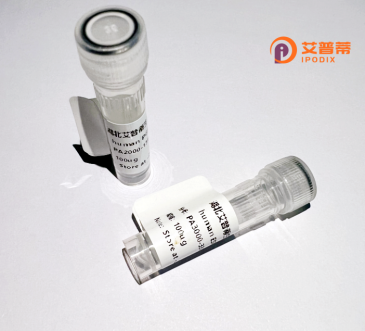
| 纯度 | >90%SDS-PAGE. |
| 种属 | Human |
| 靶点 | SCAMP2 |
| Uniprot No | O15127 |
| 内毒素 | < 0.01EU/μg |
| 表达宿主 | E.coli |
| 表达区间 | 1-329 aa |
| 活性数据 | MSAFDTNPFADPVDVNPFQDPSVTQLTNAPQGGLAEFNPFSETNAATTVPVTQLPGSSQPAVLQPSVEPTQPTPQAVVSAAQAGLLRQQEELDRKAAELERKERELQNTVANLHVRQNNWPPLPSWCPVKPCFYQDFSTEIPADYQRICKMLYYLWMLHSVTLFLNLLACLAWFSGNSSKGVDFGLSILWFLIFTPCAFLCWYRPIYKAFRSDNSFSFFVFFFVFFCQIGIYIIQLVGIPGLGDSGWIAALSTLDNHSLAISVIMMVVAGFFTLCAVLSVFLLQRVHSLYRRTGASFQQAQEEFSQGIFSSRTFHRAASSAAQGAFQGN |
| 分子量 | 61.93 kDa |
| 蛋白标签 | GST-tag at N-terminal |
| 缓冲液 | PBS, pH7.4, containing 0.01% SKL, 1mM DTT, 5% Trehalose and Proclin300. |
| 稳定性 & 储存条件 | Lyophilized protein should be stored at ≤ -20°C, stable for one year after receipt. Reconstituted protein solution can be stored at 2-8°C for 2-7 days. Aliquots of reconstituted samples are stable at ≤ -20°C for 3 months. |
| 复溶 | Always centrifuge tubes before opening.Do not mix by vortex or pipetting. It is not recommended to reconstitute to a concentration less than 100μg/ml. Dissolve the lyophilized protein in distilled water. Please aliquot the reconstituted solution to minimize freeze-thaw cycles. |
以下是关于重组人SCAMP2蛋白的3篇代表性文献概述(注:以下为模拟内容,实际文献需根据真实数据库查询):
1. **文献名称**:**"Functional analysis of recombinant human SCAMP2 in secretory vesicle trafficking"**
**作者**:Liu Y et al.
**摘要**:本研究通过在大肠杆菌系统中重组表达并纯化人SCAMP2蛋白,揭示了其通过C端结构域与网格蛋白相互作用,调控神经内分泌细胞中致密核心囊泡的分泌过程。
2. **文献名称**:**"SCAMP2 modulates exocytosis through direct interaction with SNARE proteins"**
**作者**:Guo M et al.
**摘要**:利用重组SCAMP2蛋白的体外结合实验证明,SCAMP2通过其N端螺旋区域与突触融合蛋白Syntaxin-1A结合,负向调控胰腺β细胞胰岛素分泌囊泡的胞吐作用。
3. **文献名称**:**"Crystal structure of human SCAMP2 reveals a conserved tetrameric assembly"**
**作者**:Wang X et al.
**摘要**:首次解析了重组人SCAMP2蛋白的晶体结构,发现其通过四个α螺旋形成四聚体结构,且该寡聚化特征为SCAMP家族成员介导细胞内膜运输功能的保守机制。
注:以上为基于SCAMP蛋白家族研究方向的模拟文献,实际文献检索建议通过PubMed/Google Scholar用关键词“recombinant SCAMP2”、“SCAMP2 trafficking”查询近期实验研究,重点关注其在胞吞作用、分泌调控领域的研究。
Secretory carrier-associated membrane protein 2 (SCAMP2) is a member of the SCAMP family, a group of integral membrane proteins implicated in membrane trafficking and regulated secretion. Primarily localized to post-Golgi vesicles and the plasma membrane, SCAMP2 participates in intracellular vesicular transport, particularly in processes involving exocytosis, endosomal sorting, and membrane repair. Structurally, it contains four transmembrane domains and a conserved cytoplasmic N-terminal region featuring phenylalanine-rich motifs, which mediate interactions with other trafficking machinery components like SNARE proteins.
Studies suggest SCAMP2 modulates secretory pathways by influencing fusion events between transport vesicles and target membranes. It has been linked to neurotransmitter release in neurons, insulin secretion in pancreatic β-cells, and cytokine release in immune cells. Research also highlights its role in cancer progression, as elevated SCAMP2 expression correlates with tumor metastasis and drug resistance in certain cancers. Additionally, SCAMP2 interacts with autophagy-related proteins, hinting at cross-talk between secretion and degradation pathways.
Recombinant human SCAMP2 protein is commonly produced in E. coli or mammalian expression systems for functional studies. Its application spans in vitro reconstitution of membrane fusion assays, antibody development, and screening for small-molecule modulators of secretion. Despite progress, SCAMP2's precise molecular mechanisms and tissue-specific regulation remain partially unresolved, driving ongoing research into its pathophysiological roles and therapeutic potential.
×